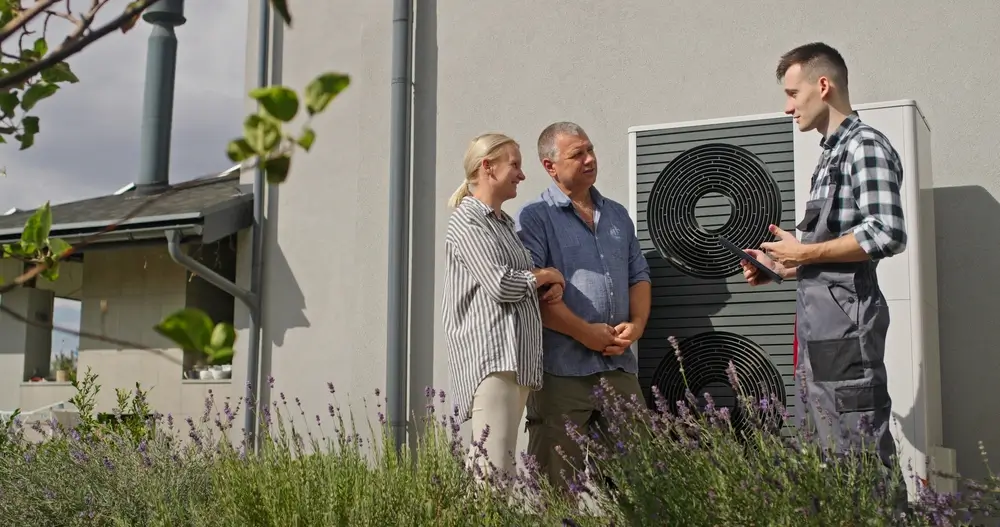With rising energy costs and increasing focus on environmental impact, many homeowners are weighing their options between heat pumps and traditional AC systems. This comprehensive guide will help you understand the pros, cons, and real costs of each option, enabling you to make an informed decision for your home.
The Basics: How Each System Works
Traditional AC Systems
- Uses refrigerant to remove heat from indoor air
- Requires separate heating system (usually a furnace)
- Only provides cooling functionality
- Typically paired with gas furnace for heating
Heat Pumps
- Moves heat between outdoors and indoors
- Both heats and cools your home
- Uses electricity as primary energy source
- Can work in temperatures as low as -13°F (newer models)
Initial Investment Comparison (2024 Prices)
Traditional AC with Gas Furnace
- Basic System: $4,500 – $7,500
- Mid-Range System: $7,500 – $10,000
- Premium System: $10,000 – $15,000
- Installation: $2,000 – $4,000
Heat Pump System
- Basic System: $5,500 – $8,500
- Mid-Range System: $8,500 – $12,000
- Premium System: $12,000 – $18,000
- Installation: $2,500 – $4,500
Note: Prices may vary by region and specific home requirements
Operating Costs: The Real Numbers
Traditional AC with Gas Furnace
Average Annual Operating Costs:
- Cooling: $500 – $900
- Heating: $600 – $1,200 (gas prices vary by region)
- Maintenance: $150 – $300
- Total Annual Cost: $1,250 – $2,400
Heat Pump
Average Annual Operating Costs:
- Cooling: $450 – $850
- Heating: $500 – $1,000
- Maintenance: $150 – $300
- Total Annual Cost: $1,100 – $2,150
Energy Efficiency Comparison
Traditional AC
- SEER Ratings: 14-21
- Cooling Efficiency: High
- Heating Efficiency: Depends on furnace (80-98% AFUE)
- Best in: Hot climates with mild winters
Heat Pump
- SEER Ratings: 14-24
- HSPF Ratings: 7.7-13.5
- Year-round Efficiency: High
- Best in: Moderate climates or with cold-climate models
Climate Considerations: What Works Where?
Hot Climates (South & Southwest)
- Traditional AC: Excellent performance
- Heat Pump: Very good performance, efficient cooling
Mixed Climates (Mid-Atlantic & Midwest)
- Traditional AC: Good performance
- Heat Pump: Excellent performance, good value
Cold Climates (North & Northeast)
- Traditional AC: Good summer performance
- Heat Pump: Good with cold-climate models
- Consider: Dual fuel systems in extreme cold
Environmental Impact
Traditional AC with Gas Furnace
- Uses refrigerants
- Burns fossil fuels for heating
- Higher carbon footprint
- Dependent on natural gas availability
Heat Pump
- Uses refrigerants
- All-electric operation
- Lower carbon footprint
- Can be paired with solar power
- Supports clean energy initiatives
2024 Tax Incentives and Rebates
Federal Incentives
- Heat Pumps: Up to $8,000 (IRA Credit)
- Traditional AC: Up to $600
- Additional credits for whole-home efficiency
State and Local Incentives
- Vary by location
- Often favor heat pumps
- May include utility company rebates
- Can significantly reduce initial costs
Long-Term Value Analysis
10-Year Cost Projection
Traditional AC with Gas Furnace:
- Initial Cost: $8,000
- Operating Costs: $20,000
- Maintenance: $2,500
- Total 10-Year Cost: $30,500
Heat Pump:
- Initial Cost: $10,000
- Operating Costs: $17,000
- Maintenance: $2,500
- Incentives: -$8,000
- Total 10-Year Cost: $21,500
Making Your Decision: Key Factors to Consider
Choose Traditional AC If:
- You live in an extremely hot climate
- Natural gas prices are low in your area
- You prefer separate heating and cooling systems
- Initial cost is your primary concern
Choose a Heat Pump If:
- You want one system for heating and cooling
- Electricity rates are reasonable in your area
- Environmental impact is important to you
- You want to maximize available tax incentives
System Lifespans and Warranty Considerations
Traditional AC
- Average Lifespan: 15-20 years
- Furnace Lifespan: 20-25 years
- Standard Warranty: 5-10 years
- Extended Options: Available
Heat Pump
- Average Lifespan: 12-15 years
- Standard Warranty: 5-10 years
- Extended Options: Available
- More frequent replacement may be needed
Installation Considerations
Professional Installation Requirements
- Both systems require certified installers
- Heat pumps need specific sizing and setup
- Traditional AC requires gas line considerations
- Proper installation crucial for efficiency
Common Installation Challenges
- Existing ductwork compatibility
- Electrical system requirements
- Outdoor unit placement
- Local building codes and permits
Making Your Final Decision
Consider these key questions:
- What’s your local climate?
- How long do you plan to stay in your home?
- What are your local energy rates?
- What’s your budget for initial investment?
- How important is environmental impact?
Ready to explore your options? Contact our team at National Air Warehouse for personalized recommendations and pricing. We can help!

